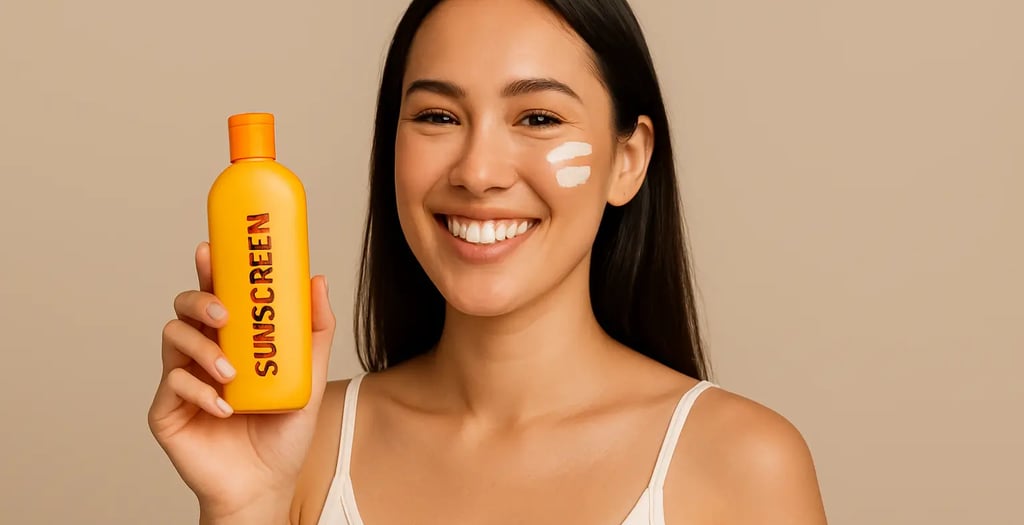What Is Sunscreen? Benefits, Types, Ingredients & Safety Explained
Learn what sunscreen is, how it works, its types, ingredients, pros, cons, and why daily use is vital for sun protection, anti-aging, and skin cancer prevention.


🧴 What Is Sunscreen?
Sunscreen is a topical product—available as lotions, creams, gels, or sprays—designed to protect the skin from the sun’s harmful ultraviolet (UV) rays. These rays, particularly UVA and UVB, can lead to skin damage, sunburn, premature aging, and even skin cancer. Sunscreen acts as a protective barrier by either absorbing or reflecting UV radiation, making it an essential component of any daily skincare and sun safety routine.
There are two primary categories:
Chemical Sunscreens: Contain organic compounds like avobenzone, octinoxate, or oxybenzone that absorb UV rays and convert them into harmless heat.
Physical (Mineral) Sunscreens: Use natural minerals like zinc oxide or titanium dioxide to physically block and reflect UV rays from the skin.
A key factor in choosing sunscreen is its Sun Protection Factor (SPF). SPF measures protection against UVB rays—the ones responsible for sunburn. For example, SPF 30 offers about 97% protection when applied correctly, but it must be reapplied every 2 hours, especially after swimming or sweating.
✅ Benefits of Using Sunscreen
Regular sunscreen use offers numerous dermatological and cosmetic benefits:
Reduces Risk of Skin Cancer: Daily use lowers the chances of developing melanoma and other skin cancers.
Prevents Premature Aging: Protects against photoaging, reducing wrinkles, fine lines, and pigmentation.
Preserves Even Skin Tone: Shields against dark spots and discoloration caused by sun exposure.
Year-Round Protection: UV rays can penetrate clouds and windows, making daily use essential regardless of weather or season.
Pro Tip: Look for broad-spectrum sunscreen, which protects against both UVA (aging) and UVB (burning) rays.
⚠️ Sunscreen Concerns and Limitations
Despite the many benefits, sunscreen usage isn’t without drawbacks:
Skin Irritation: Some chemical ingredients (like oxybenzone or avobenzone) may trigger allergic reactions in sensitive individuals.
Environmental Impact: Chemicals like oxybenzone and octinoxate are linked to coral reef damage. Always opt for reef-safe sunscreen when swimming in oceans.
False Sense of Security: Sunscreen doesn’t grant unlimited sun exposure. Protective clothing, hats, and shade are still essential.
👉 Best Practice: Apply sunscreen 15 minutes before sun exposure and reapply every 2 hours or immediately after sweating or swimming.
🧪 What’s in Your Sunscreen? (Ingredients Breakdown)
Active Ingredients
Mineral Sunscreens:
Zinc Oxide: Broad-spectrum protection; great for sensitive skin.
Titanium Dioxide: Primarily blocks UVB and short UVA rays.
Chemical Sunscreens:
Avobenzone: Absorbs the full spectrum of UVA rays.
Octisalate and Octocrylene: Stabilize the formula and provide additional UVB protection.
Oxybenzone: Controversial; effective but may cause irritation or environmental harm.
Inactive Ingredients
Moisturizers (e.g., glycerin, hyaluronic acid): Prevent dryness.
Antioxidants (e.g., vitamin C & E): Combat free radicals from UV exposure.
Preservatives (e.g., parabens or phenoxyethanol): Extend shelf life and maintain hygiene.
🌤 Who Should Use Sunscreen?
Everyone. Regardless of skin tone, age, or lifestyle, sunscreen is crucial. People with darker skin tones are still vulnerable to UV damage, although they may not burn as quickly.
Choose based on skin type:
Oily/Acne-prone skin → Gel-based or mineral sunscreens labeled “non-comedogenic”
Sensitive skin → Fragrance-free mineral sunscreens
Dry skin → Cream-based with moisturizing agents
🛡️ How to Apply Sunscreen Effectively
Use at least a nickel-sized amount for the face and one ounce (a shot glass) for the body.
Apply 15–30 minutes before sun exposure.
Reapply every 2 hours, or after swimming, sweating, or towel-drying.
Don’t forget areas like ears, neck, hands, and feet.
🌱 Eco-Friendly Sunscreen Tips
Look for “reef-safe” or “ocean-friendly” on labels.
Avoid aerosols, which may pollute and disperse unevenly.
Choose biodegradable and mineral-based formulas for outdoor use.
Frequently asked questions
Q1: Can sunscreen expire?
Yes, most sunscreens expire 3 years after manufacture. Always check the label.
Q2: Do I need sunscreen indoors?
Yes, especially if near windows, as UVA rays can penetrate glass.
Q3: Is SPF 100 much better than SPF 50?
Not significantly. SPF 50 blocks ~98% of UVB, SPF 100 blocks ~99%. Proper application is more important.
Q4: Can I use sunscreen with makeup?
Yes, apply sunscreen first. Some cosmetics include SPF, but layering is best for full protection.
